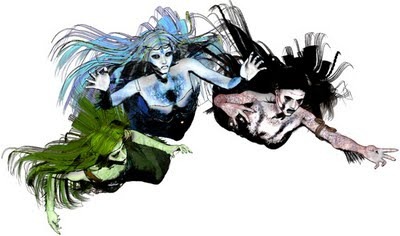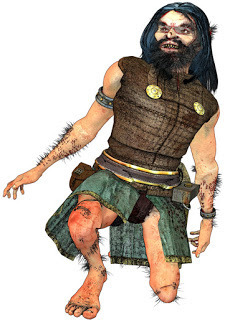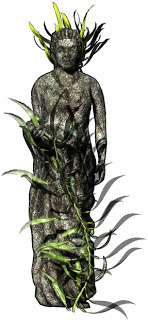Formatting Graphics for the Kindle
 I've talked a bit about getting images into the Kindle in prior posts, but in the meantime I've done some experiments and tests and thought I'd share some of what I've learned.
I've talked a bit about getting images into the Kindle in prior posts, but in the meantime I've done some experiments and tests and thought I'd share some of what I've learned.Firstly, of course, the current Kindle screen can only reproduce images in 16 shades of gray, so the best graphics use fewer colors in high contrast lights and darks. Otherwise you'll lose a lot of detail. So something that looks a bit "cartoonish" is really best, with dark outlines and lighter color fills. But a blend of dark and light color works just fine as well. You'll want to retain some of the color present in your images, and not just convert them to gray, because your book may also be read in Kindle apps on color screens. And at some point the Kindle itself will get a color screen. Of course, if your images are already black and white or gray this isn't a concern.
 The second major issue is image size and resolution, and this is a little bit trickier. As I mentioned before, while the Kindle screen size is 800x600 pixels, due to its page margins the actual maximum size for interior graphics is 622x520. You can override the default 1/2" margin setting in your header coding, so long as you use very clean and systematic CSS styles to retain proper margins for your text, but I find it a bit disconcerting to have inconsistent alternating margins, so I've opted to retain the defaults myself. This is generally a best practice anyway, but be aware that you can change the margin spacing if you want to.
The second major issue is image size and resolution, and this is a little bit trickier. As I mentioned before, while the Kindle screen size is 800x600 pixels, due to its page margins the actual maximum size for interior graphics is 622x520. You can override the default 1/2" margin setting in your header coding, so long as you use very clean and systematic CSS styles to retain proper margins for your text, but I find it a bit disconcerting to have inconsistent alternating margins, so I've opted to retain the defaults myself. This is generally a best practice anyway, but be aware that you can change the margin spacing if you want to.Where image size becomes more difficult is in dealing with the various screen sizes for devices that handle the Kindle app. The iPad's landscape layout, for example, creates pages slightly smaller than the Kindle's, at 412x544 ppi, plus three 1/2" margins horizontally (left, center, right) and upper and lower margins of 3/4" and 1" respectively. However, in portrait mode the iPad's Kindle app converts to a 792x554 pixel area, plus margins, without increasing either font or image size (the iPad's overall screen size is 1024x768). Consequently, images inserted at the native Kindle reader size will look very small surrounded by all that extra text.
 In addition, image resolution is a major consideration. The Kindle's native resolution is 167 pixels per inch, while the iPad's is only 132. Interestingly, the original black and white eInk Nook and Sony readers both have screen specs exactly the same as the newest Kindle. The newer NookColor's LCD screen, meanwhile, is 1024x600 at 169 ppi - the same height as the iPad is wide, but narrower and with slightly higher resolution to fit images into its smaller 7" screen. The larger format Kindle DX, by the way, has a screen size of 1200x824 at 150 ppi, although I've never met anybody who actually has one.
In addition, image resolution is a major consideration. The Kindle's native resolution is 167 pixels per inch, while the iPad's is only 132. Interestingly, the original black and white eInk Nook and Sony readers both have screen specs exactly the same as the newest Kindle. The newer NookColor's LCD screen, meanwhile, is 1024x600 at 169 ppi - the same height as the iPad is wide, but narrower and with slightly higher resolution to fit images into its smaller 7" screen. The larger format Kindle DX, by the way, has a screen size of 1200x824 at 150 ppi, although I've never met anybody who actually has one.As far as the other major tablets go, both the Motorola Xoom and 10.1" Galaxy Tab boast the largest screens, these being 1280x800 ppi at 160 and 149 ppi respectively (making the Xoom the overall pixel winner). The 7" Tab, by the way, is 1024x600 @ 171 ppi, nearly identical to the Color Nook. And to confuse matters further, Kindle apps are found on iPhones (640x960 @326ppi for the iPhone 4) and Androids (480x854 @228ppi for the Droid X), their smaller screen sizes being made up for by greatly increased pixel density.
And finally, if you're using Word to do your writing and layout, any images imported there will be automatically converted to its native 96dpi format, which I find to be a good compromise due to the Kindle's limitation on file size: images must be 127kb or less, and any that are larger than this are automatically resized at the expense of image quality, so take care in creating graphics that meet this stipulation.
Interestingly, at 96dpi images are sized most accurately on the iPad, even though its screen resolution is higher. I did a series of experiments for this using incrementally sized versions of the image below to see at what size they looked best, and at what point the image was resized to fit the screen. An image 554 pixels wide at 96 dots per inch displayed edge to edge with no resizing or noticeable artifacts in either the horizontal or vertical grids, while higher resolution images no longer reached each edge and lower ones distorted the alternating lines into shades of gray (a good sign that the image has been resized). Each black and white line on the left is one pixel in width, while the lines on the right are two pixels wide.
 The solution to all this, for me, was to format my images for the largest logical screen size, that of the iPad in portrait mode, and let the Kindle scale the graphics down to fit its screen. Since the Kindle reader can't reproduce high quality pictures anyway, it seemed far less drastic than compromising the more pristine, high-contrast screens found on tablet readers. Plus, screens are only bound to get better, so that in a year or two the Kindle will boast far better graphics than it does right now, and having those already loaded in will save a lot of time and frustration later.
The solution to all this, for me, was to format my images for the largest logical screen size, that of the iPad in portrait mode, and let the Kindle scale the graphics down to fit its screen. Since the Kindle reader can't reproduce high quality pictures anyway, it seemed far less drastic than compromising the more pristine, high-contrast screens found on tablet readers. Plus, screens are only bound to get better, so that in a year or two the Kindle will boast far better graphics than it does right now, and having those already loaded in will save a lot of time and frustration later.
Published on August 24, 2011 21:29
No comments have been added yet.



